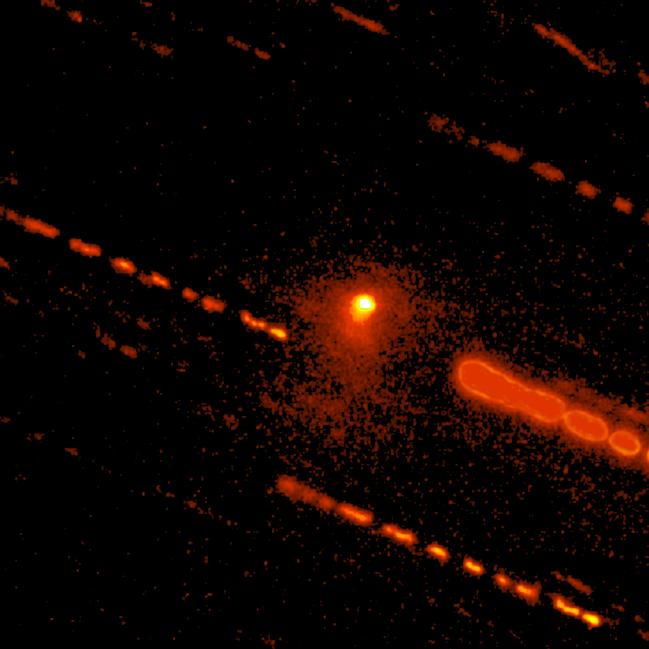Findings lead to reclassification of Centaur as comet

Credit: Courtesy Northern Arizona University
Centaurs are minor planets believed to have originated in the Kuiper Belt in the outer solar system. They sometimes have comet-like features such as tails and comae–clouds of dust particles and gas–even though they orbit in a region between Jupiter and Neptune where it is too cold for water to readily sublimate, or transition, directly from a solid to a gas.
Only 18 active Centaurs have been discovered since 1927, and much about them is still poorly understood. Discovering activity on Centaurs is also observationally challenging because they are faint, telescope time-intensive and because they are rare.
A team of astronomers, led by doctoral student and Presidential Fellow Colin Chandler in Northern Arizona University’s Astronomy and Planetary Science PhD program, earlier this year announced their discovery of activity emanating from Centaur 2014 OG392, a planetary object first found in 2014. They published their findings in a paper in The Astrophysical Journal Letters, “Cometary Activity Discovered on a Distant Centaur: A Nonaqueous Sublimation Mechanism.” Chandler is the lead author, working with four NAU co-authors, graduate student Jay Kueny, associate professor Chad Trujillo, professor David Trilling and PhD student William Oldroyd.
The team’s research involved developing a database search algorithm to locate archival images of the Centaur as well as a follow-up observational campaign.
“Our paper reports the discovery of activity emanating from Centaur 2014 OG392, based on archival images we uncovered,” Chandler said, “plus our own new observational evidence acquired with the Dark Energy Camera at the Inter-American Observatory in Cerro Tololo, Chile, the Walter Baade Telescope at the Las Campanas Observatory in Chile and the Large Monolithic Imager at Lowell Observatory’s Discovery Channel Telescope in Happy Jack, Ariz.”
“We detected a coma as far as 400,000 km from 2014 OG392,” he said, “and our analysis of sublimation processes and dynamical lifetime suggest carbon dioxide and/or ammonia are the most likely candidates for causing activity on this and other active Centaurs.”
“We developed a novel technique,” Chandler said, “that combines observational measurements, for example, color and dust mass, with modeling efforts to estimate such characteristics as the object’s volatile sublimation and orbital dynamics.”
As a result of the team’s discovery, the Centaur has recently been reclassified as a comet, and will be known as “C/2014 OG392 (PANSTARRS).”
“I’m very excited that the Minor Planet Center awarded a new comet designation befitting the activity we discovered on this unusual object,” he said.
This week, Chandler has been invited to present the results at the 52nd Division of Planetary Science (DPS) of the American Astronomical Society (AAS) 2020 meeting.
###
Chandler’s research is funded by Grant No. 2018258765 through the National Science Foundation’s Graduate Research Fellowship Program (GRFP), a highly competitive opportunity that only about 2,000 students receive each year.
About Northern Arizona University
Northern Arizona University is a higher-research institution providing exceptional educational opportunities in Arizona and beyond. NAU delivers a student-centered experience to its 31,000 students in Flagstaff, statewide and online through rigorous academic programs in a supportive, inclusive and diverse environment. Dedicated, world-renowned faculty help ensure students achieve academic excellence, experience personal growth, have meaningful research opportunities and are positioned for personal and professional success.
Media Contact
Colin Orion Chandler
[email protected]




